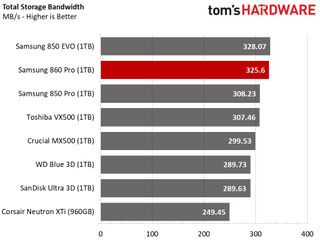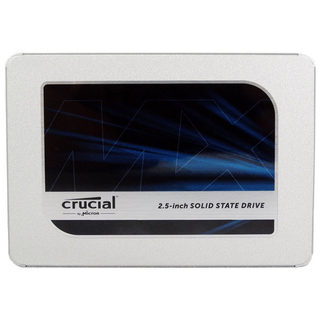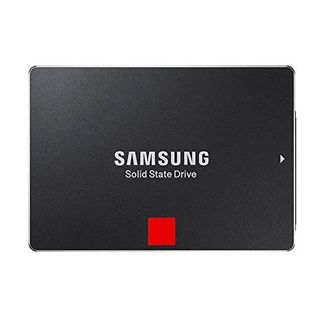Samsung 860 Pro SSD Review
Why you can trust Tom's Hardware
1TB Class Performance
Comparison Products
We pulled out the newer high-performance 1TB-class drives to compare to the new Samsung 860 Pro. Samsung has two 850-series drives in this class. The 850 EVO 1TB has been our go-to recommendation for three years. Until the last few months, no other SSD could overshadow its mix of performance, endurance, and price. The Samsung 850 Pro is the SSD you use in a heavy write environment where its extended endurance and better performance in mixed workloads increases productivity in professional applications.
The Corsair Neutron XTi and Toshiba VX500 are newer products that never really took off with enthusiasts. The drives deliver a good user experience, but they often cost much more than the industry-standard 850 EVO.
Three newcomers came to market in late 2017 and re-energized the SATA SSD market by matching the 850 EVO's performance at lower price points. The Western Digital Blue 3D and SanDisk Ultra 3D are nearly identical drives, but they often sell at slightly different price points because they target different markets. Both feature SanDisk's 64-layer 3D TLC flash.
The Crucial MX500 also features 64-layer 3D TLC flash, but it comes from Micron (Crucial's parent company). You could argue the MX500 is the SSD that forced Samsung to finally update the aging 850 product line.
Sequential Read Performance
To read about our storage tests in-depth, please check out How We Test HDDs And SSDs. We cover four-corner testing on page six of our How We Test guide.


The sequential tests are uneventful. All the drives deliver between 550 and 560 MB/s at high queue depths. The queue depth (QD) 1 and 2 sequential read performance is also within 30 MB/s with these 1TB-class drives. Later in the review, we'll see some differences that set the drives apart, but these products all saturate the SATA interface during basic workloads.
Sequential Write Performance


Advanced SLC caching technology leverages a small high-performance buffer that fills quickly during large file transfers. That can slow transfer speeds to a crawl. The 860 Pro's MLC flash delivers consistent performance across the entire LBA range, so the company doesn't use the slightly-faster SLC write buffer like it does with EVO products.
Random Read Performance



The Samsung 860 Pro is faster than the 850 Pro in the random read workload. The new 64-layer flash is less latent than the older 32- and 48-layer. We found a similar improvement in the PM981 compared to the existing 960 NVMe products.
The 860 Pro leaps back over the MX500 that recently overtook the 850 Pro and EVO in low-QD random read workloads. The 860 Pro sets new performance records for SATA SSDs at QD4 and QD8.
Random Write Performance



The 860 Pro's random write performance remains impressive. We expected the drive to overtake the older 850 in this test, but it came up a little short in our new burst testing. Later in the review, we'll show a sustained 4KB random write workload where the new drive enjoys a comfortable lead.
70% Mixed Sequential Workload
We describe our mixed workload testing in detail here and describe our steady state tests here.


The 860 Pro delivers moderate performance gains in most areas over the previous generation models, but we find the biggest gains in the critical mixed workloads. We measured more than a 100 MB/s increase over the 850 Pro in the mixed sequential test at QD2 and QD4. This benefits storage-bound photo and video applications.
70% Mixed Random Workload


Samsung once again takes the lead over the competition. The 860 Pro 1TB delivers nearly 5,000 more IOPS than the 850 Pro at QD2.
Sequential Steady-State



The 860 Pro also provides a nice performance boost for sequential steady-state workloads. In the first chart, we examine various read and write mixtures. The 850 Pro's class-leading performance consistency led the industry when it first came to market. Things have changed over the last few years, and the competition has overtaken Samsung’s aging prosumer line. The 860 series regains the lead in many of the workloads.
Random Steady-State



We had to add a third image to zoom in on the results. The 860 Pro's MLC flash delivers consistent steady-state performance that flutters slightly around the 12,000 IOPS mark, which is slightly higher than the other drives. We would recommend the 860 Pro for desktop RAID arrays, NAS, or small business servers.
PCMark 8 Real-World Software Performance
For details on our real-world software performance testing, please click here.










The 860 Pro wins some, loses some, and ties in many of the consumer-focused tests. The results are all over the board compared to the other products. It certainly isn't what we expected, but this is good for consumers because it means we are reaching near-parity in the broader market. We expected the 860 Pro to really deliver in the Photoshop Heavy test, but it trailed the other drives. Everything leading up to this point suggested the drive would dominate that application.
Application Storage Bandwidth

The new 860 Pro couldn't displace the 850 EVO from the top position, but it did outperform the 850 Pro by a small margin in the application tests. We're excited to see what the 860 EVO can do in these tests.
PCMark 8 Advanced Workload Performance
To learn how we test advanced workload performance, please click here.



Samsung designed the 860 Pro to retain as much performance as possible during heavy use and still provide users with a snappy user experience. That includes using an aggressive garbage collection algorithm that allows the drive to recover faster than normal consumer SSDs.
Total Service Time



The highest PCMark 8 throughput score doesn't always equate to the best latency. The service time tests show the 860 Pro 1TB in the middle of the chart surrounded on both sides by other products during the heavy workloads. We've tested these products in the past and found that several of them can outperform the 850 Pro under these conditions.
The challenge for the other contenders comes when we move back to lighter workloads. The 860 Pro can recover much faster than the Crucial, Toshiba, and 850 EVO. The WD, SanDisk, and 850 Pro still perform slightly better than the new 860 Pro, but they also have a time advantage. The other products have been on the market for much longer and have mature firmware. The 860 Pro isn't on sale yet and will receive firmware updates over time to increase performance.
Disk Busy Time

Disk busy time measures how long the drive works to complete a series of tasks. This is different than measuring how long it takes the system to complete the task. Other factors inflate that measurement, like CPUs and Windows. These tests often have a strong correlation with the notebook battery life tests we'll cover shortly.
The 860 Pro works longer during heavy workloads than the WD and SanDisk drives. Samsung's Pro series is no longer the best in every category like it was when the company first released it three years ago.
BAPCo SYSmark 2014 SE Responsiveness Test


We use a Lenovo Y700-17 gaming notebook for our BAPCo tests. The 860 Pro delivered the best system responsiveness score. The score is better than any other SATA SSD we've tested to date, but it's well under Samsung's NVMe SSDs.
BAPCo MobileMark 2012.5 Notebook Battery Life
To learn how we test advanced workload performance, please click here.


The 860 Pro came up short in our notebook battery life test, but that's likely due to early firmware. Companies often optimize for power consumption last. We're the only website that investigates performance under these conditions, so it's not a high priority for vendors until the drives ship to resellers.
MORE: Best SSDs
MORE: How We Test HDDs And SSDs
MORE: All SSD Content
Stay on the Cutting Edge
Join the experts who read Tom's Hardware for the inside track on enthusiast PC tech news — and have for over 25 years. We'll send breaking news and in-depth reviews of CPUs, GPUs, AI, maker hardware and more straight to your inbox.



